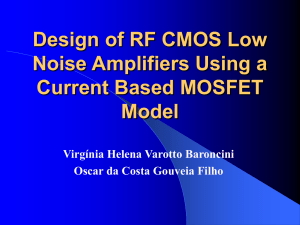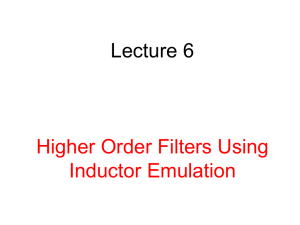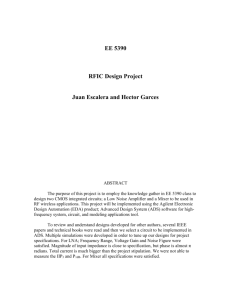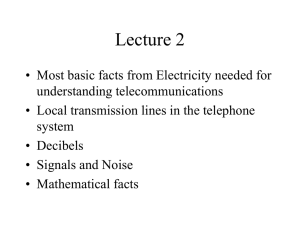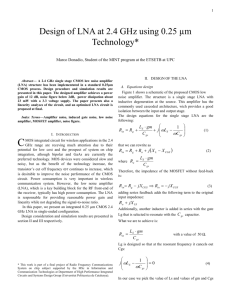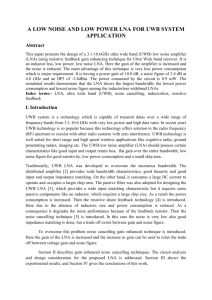SI_REV - AIP FTP Server
advertisement
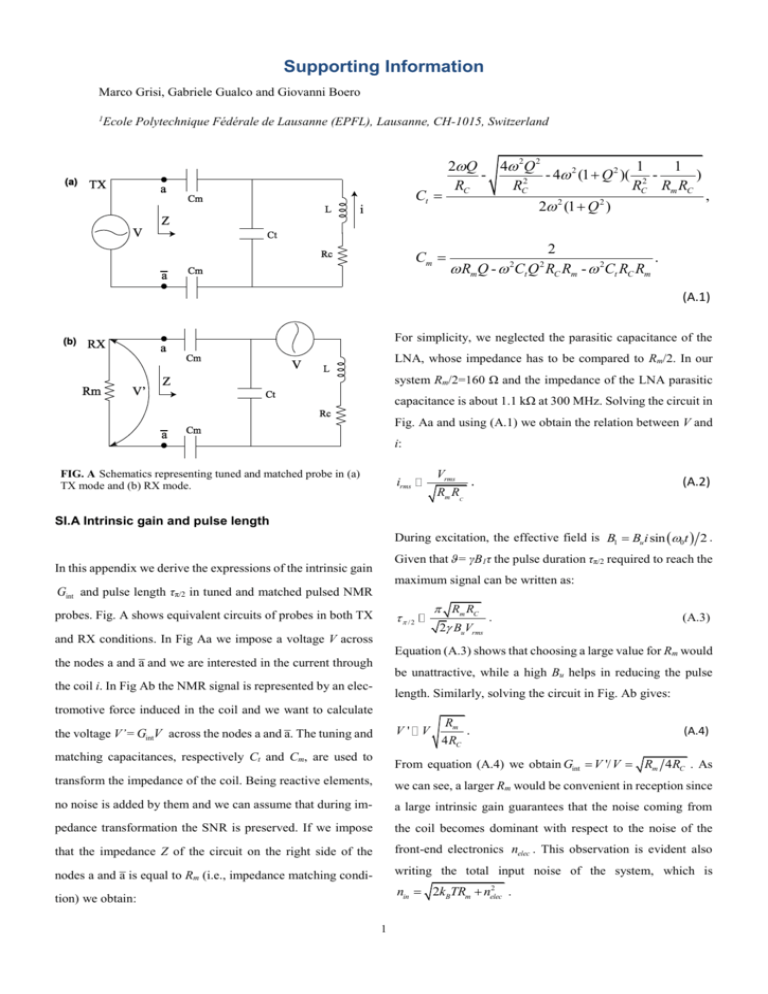
Supporting Information Marco Grisi, Gabriele Gualco and Giovanni Boero 1 Ecole Polytechnique Fédérale de Lausanne (EPFL), Lausanne, CH-1015, Switzerland 2Q 4 2Q 2 1 1 - 4 2 (1 Q 2 )( 2 ) 2 RC RC RC Rm RC Ct , 2 2 (1 Q 2 ) Cm 2 . RmQ - Ct Q RC Rm - 2Ct RC Rm 2 2 (A.1) For simplicity, we neglected the parasitic capacitance of the LNA, whose impedance has to be compared to Rm/2. In our system Rm/2=160 Ω and the impedance of the LNA parasitic capacitance is about 1.1 kΩ at 300 MHz. Solving the circuit in Fig. Aa and using (A.1) we obtain the relation between V and i: FIG. A Schematics representing tuned and matched probe in (a) TX mode and (b) RX mode. irms SI.A Intrinsic gain and pulse length Vrms Rm RC . (A.2) During excitation, the effective field is B1 Bu i sin 0t 2 . Given that ϑ= γB1τ the pulse duration τπ/2 required to reach the In this appendix we derive the expressions of the intrinsic gain maximum signal can be written as: Gint and pulse length τπ/2 in tuned and matched pulsed NMR /2 probes. Fig. A shows equivalent circuits of probes in both TX and RX conditions. In Fig Aa we impose a voltage V across Rm RC 2 BuVrms . (A.3) Equation (A.3) shows that choosing a large value for Rm would the nodes a and a̅ and we are interested in the current through be unattractive, while a high Bu helps in reducing the pulse the coil i. In Fig Ab the NMR signal is represented by an elec- length. Similarly, solving the circuit in Fig. Ab gives: tromotive force induced in the coil and we want to calculate Rm . 4 RC (A.4) the voltage V’= GintV across the nodes a and a̅. The tuning and V' V matching capacitances, respectively Ct and Cm, are used to From equation (A.4) we obtain Gint V '/ V Rm 4RC . As transform the impedance of the coil. Being reactive elements, we can see, a larger Rm would be convenient in reception since no noise is added by them and we can assume that during im- a large intrinsic gain guarantees that the noise coming from pedance transformation the SNR is preserved. If we impose the coil becomes dominant with respect to the noise of the that the impedance Z of the circuit on the right side of the front-end electronics nelec . This observation is evident also nodes a and a̅ is equal to Rm (i.e., impedance matching condi- writing the total input noise of the system, which is 2 . nin 2kBTRm nelec tion) we obtain: 1 Mp2) , RL is the output resistance, γ is a technological constant SI.B Integrated electronics design approximately equal to 2/3, gmm is the transconductance of the current mirror devices (Mp3, Mp4, Mp5, Mp6) ,Kfn and Kfp are Receiver the flicker noise constants of n and p devices respectively, C L and Ci are the sum of the capacitances connected to the output The transistor level schematics of the main elements of the re- and input nodes, including the MOS parasitics. Equation (B.1) ceiver are shown in Fig. Ba-c. The dimensions of all the ob- points out that, maximizing the input transconductance and jects shown are listed in Table A. The main transistor level designing the current mirror devices in strong inversion (i.e. design challenge is to trade-off between the wide bandwidth with small aspect ratio, small gm), it is possible to make neg- (1-300 MHz) and low input referred noise (about 1 nV/ Hz ligible the noise due to transistors other than the input trans- ) requirements. In integrated circuit high frequency operation conductor. Furthermore, noises of cascode devices and load (i.e. in the GHz range) is achieved by using small area transis- resistances are negligible thanks to particular structure for the tor sizes. Small devices have smaller parasitic capacitance and former, and to the voltage gain division for the latter. After hence better speed performance. On the other hand they have this consideration we found the following a good design strat- larger flicker noise with corner frequency in the MHz range egy: to trade-off between noise and speed a gm/I ratio of 10 is limiting their functionality for low frequency operation. been chosen as a starting point for the input devices.3 The min- Shown in Fig. Ba is the transistor level schematic of the low imum input transistor area is set by the noise performances at noise amplifier. The device amplifies the small NMR signal in low frequency (flicker noise). The minimum transconductance order to make the noise contribution of the following down- is set by the thermal noise floor (i.e. for frequencies typically conversion device (mainly the frequency mixer) negligible. above 20 MHz).To maximize the transconductances per unit For the external coil case the minimum input noise is about area, the devices are designed with short lengths and large 1.8 nV/ Hz , set by the 160 Ω equivalent input impedance in widths. The supply current is then used to tune the transcon- matched conditions. Since the noise of a frequency mixer is in ductance in order to achieve the wanted noise. After designing the order of few tens of nV/ Hz ,1 the 39 dB gain of the LNA the input transconductance, the resistive load is decided in is enough to not deteriorate the SNR in the following circuitry. function of the desired gain. Since the structure is fully differ- The chosen scheme, inspired by Ref. [2], is a current reuse dif- ential, a feedback has to be added to ensure the stability of the ferential transconductance, loaded with a pseudo cascode. The output common mode voltage. This is done by mean of tran- voltage gain, input referred noise and main frequency pole can sistors (Mn5, Mn6 Mp7, Mp7) which set the output dc voltage at be expressed, in first approximation, by the following equa- a level which is about 1 V. In figure Bb a double balance Gil- tions: bert cell mixer is shown. This active mixer is chosen among A υ = gm p +gm n ×R L f p1 = f p2 = others for its simplicity and for noise performances, which are 1 2πR L ×CL better if compared with the passive counterpart. Transistors Mn1,2 together with Rs1,2 act as transconductance, converting gds p +gds n +gm B the voltage signal coming from the LNA into a current. Tran- (B.1) 2πCi sistor Mn3-6, driven by the local oscillator, multiply the current K fp 4k B Tγ K fn v = + + + gm p +gm n WL n f WL p f 2 n 4k B Tγgm m gm p +gm n 2 + K f gm m2 WL m f gm p +gm n 2 signal by a square wave. The resulting signal is composed by + sinusoids with frequency equal to the sum and difference of 4k B TR L A 2v the one driving the mixer. The sum component is filtered out by the load filter, leaving a sinusoid oscillating at the differ- where gmp,gmn, gdsp and gdsn are the gate-drain and drain- ence in frequency between the signal and the local oscillator. source transconductances of the input devices (Mn1, Mn2, Mp1, 2 Again, the minimum size of the input devices is chosen to keep equal to f p =1 2πR F C F is added to filter out the sum compo- the input referred noise in a reasonable range (10 nV) and the nent. In Fig. Bc the audio frequency amplifier following the transistor Mn3-6 are sized to behave as hard switches when mixer is detailed. The design rules considered to size the tran- driven by a 1.5 V peak-to-peak square wave at 1 GHz. With sistors are the same ones discussed for the pre-amplifier. A this assumption the voltage gain can be written as resistive feedback is then added to control voltage gain. Av = 4R L πRs . At the output a low pass filter with frequency LNA Object name Width (μm) Length (μm) Mn1, Mn2 350 0.18 Mn3, Mn4 70 0.13 Mn4, Mn6 40 0.13 Mp1, Mp2 840 0.18 Mp3, Mp4 150 0.2 Mp5 450 0.25 Mp6 290 0.25 Mp8, Mp8 45 0.25 Mp1, Mp2 15 0.4 Mp3, Mp4, Mp5, Mn6 50 0.13 MIXER RS1,RS2 300 Ω RL 2 kΩ RF 100 kΩ CF 20 pF AF amplifier Mn1, Mn2 100 3 Mn3, Mn4 30 0.3 Mp1, Mp2 70 4 Mp3, Mp4 60 0.5 Mp5, Mp6 35 4 RI1,RI2 6 kΩ RF1,RF2 18 kΩ RL 10 kΩ RI1,RI2 400 Ω CC1, CC2 3 pF TAB. A Design physical dimensions. FIG B: Detailed schematics of (a) LNA, (b) Mixer, (c) AF amplifier. 3 Transmit-receive switches The transistor level schematic of the transmit-receive switches is shown in Fig. C. The schematic shows how the interface between transmitter and receiver is realized for one of the two differential inverters chains. In the case shown, the total number of inverters is even and a few straightforward adjustments have to be done to construct the other differential pair (whose number of inverters is odd). When the control signal s=2.5 V (s̅=0) we are selecting the RX mode and the inverter chain is FIG C: Detail of transmit-receive switches in stand-by. In the opposite configuration the inverters are transmitting power to the probe and the switches on the re- 1 Behzad Razavi, RF microelectronics. (Prentice Hall New Jersey, 1998). J. Anders, P. SanGiorgio, and G. Boero, J Magn Reson 209 (1), 1 (2011). 3 Willy MC Sansen, Analog design essentials. (Springer, 2007). ceiver side protect the LNA. 2 4
